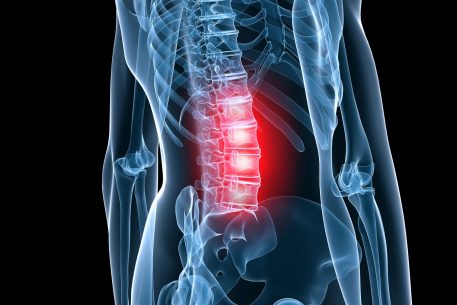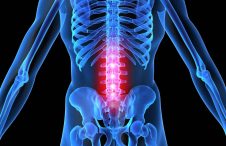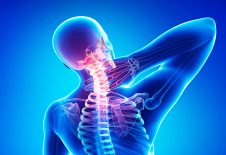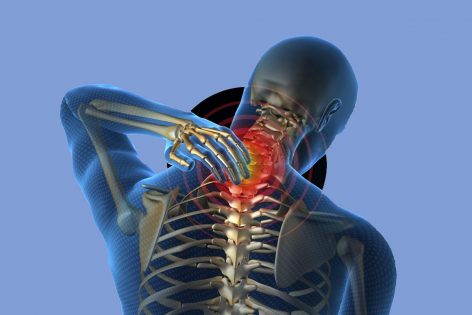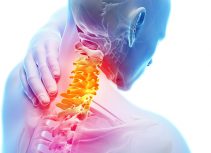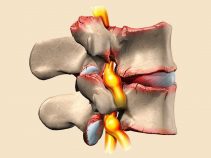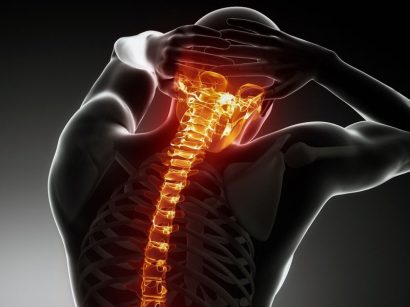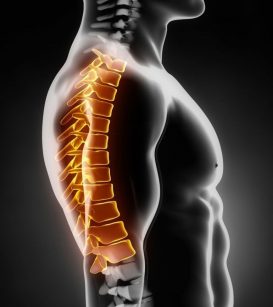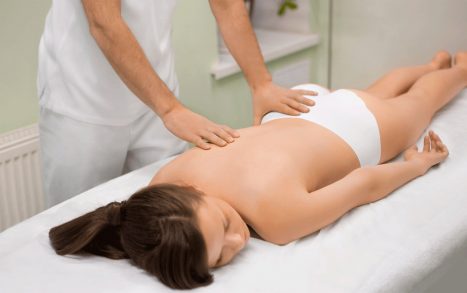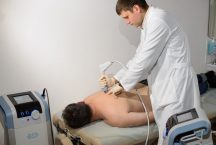Treatment of osteochondrosis, depending on its type and stage, can be either conservative or surgical. The decision is made by the doctor based on the history and complaints of the patient. As a rule, in case of minor pain, you can do with medication, massage and therapeutic exercises.
If the situation is neglected, then surgical intervention is often required. In order for the disease not to be taken by surprise, you need to know what osteochondrosis is, what it happens and how it manifests itself, as well as the main ways to treat this ailment.
Material Content:
What is osteochondrosis and its causes
Osteochondrosis is a disease in which intervertebral disc deformation occurs. They begin dystrophic disturbances under the influence of adverse factors. The distance between the vertebrae becomes smaller, which leads to pinching of the nerve endings and provokes severe pain in the neck, chest or lower back, which depends on the location of the pathology.
The causes of the disease can be:
- Hereditary predisposition. If one of the next of kin has back problems, you need to carefully monitor the condition of your own spine.
- Diseases of the musculoskeletal system. Scoliosis, kyphosis, flat feet in the absence of treatment can provoke the appearance of the disease.
- Unhealthy Lifestyle. Lack of physical activity, overweight, unbalanced diet, bad habits and constant stresses are provoking factors for the appearance of osteochondrosis.
- Pregnancy. While waiting for the baby, the load on the spine increases many times.This can lead to pinching and incorrect position of the vertebrae.
- Injuries. Strong bruises often cause spinal problems.
- Unsuitable working conditions. The need to carry heavy loads, working with chemicals is one of the causes of the disease.
- Inconvenient berth. If the spine is in an unnatural position during a night's rest, this will lead to numerous problems.
- Hormonal Failures.https: //www.youtube.com/watch? V = BfxJTf_Upko
Even one of the above reasons can be an impetus to the development of the disease.
Disease classification
Depending on where exactly the deformation of the intervertebral discs occurred, the following types of disease are distinguished:
- osteochondrosis of the cervical spine;
- osteochondrosis of the thoracic spine;
- osteochondrosis of the lumbar spine.
Manifestations may vary slightly, but the main signs - stiffness of movements and pain, are characteristic of all three types of ailment.
Symptoms and signs
Symptoms of osteochondrosis depend on its variety and may be as follows:
- With cervical osteochondrosis, patients complain of constant headache, goosebumps, discomfort in the upper limbs, nausea and ringing in the ears. In some cases, fainting is possible.
- Thoracic osteochondrosis is often confused with heart pathologies. Patients complain of a feeling of constriction and chest pain, numbness of the hands and weakness. Often there are problems from the digestive tract, such as diarrhea, bloating and inflammation of the pancreas.
- Lumbar osteochondrosis is characterized by pain in the sacral region, it gives to the lower extremities. Lumbago often occurs, motor activity is worse. Https: //www.youtube.com/watch? V = XXM5mxoyHX0
If the above signs appear, you need to contact a neurologist as soon as possible to undergo an examination and prescribe treatment.
How is the diagnosis
First, the patient is examined, the doctor collects an anamnesis, finding out the presence of chronic diseases, lifestyle, the nature of the work performed, the presence of injuries and stresses.
After this, the patient is sent to the following studies:
- Analysis of urine and blood. They help establish the presence of an inflammatory process in the body.
- X-ray, MRI and CT. All these methods are aimed at a thorough study of the spinal column. With their help, processes occurring in the spine, the presence of pinching and hernias, as well as the condition of the intervertebral discs are revealed.
After receiving the results, the doctor prescribes treatment.
Methods of treating osteochondrosis
There are 2 main methods of treating pathology - conservative and surgical. The first is resorted to in cases where the disease is detected at an early stage and can be easily corrected.
The operation is performed when conventional methods do not give results, and the patient's condition rapidly deteriorates. Which treatment tactics should be preferred, the attending physician decides.
Conservative
These include drug treatment, massages, physiotherapy exercises, physiotherapy and manual therapy. All of them are aimed at relieving inflammation, pain, strengthening the spinal column and preventing the destruction of the intervertebral discs.
Surgical
Spinal surgery for osteochondrosis is resorted to in extreme cases when the pain syndrome cannot be removed with any medication, the patient's motor activity is significantly reduced, and massages and gymnastics do not give a result.
Surgical intervention on the spine is a complex procedure, therefore, it must be performed by a highly qualified surgeon in a hospital.
When the nerve root is pinched, it will be necessary to remove the part of the disk that causes compression of the nerve endings. If there was a complete destruction of the intervertebral disc, then a prosthesis is installed in its place.
After surgery, the patient will require long-term rehabilitation and thorough care.Therefore, do not bring the situation to the point that there is an urgent need for surgical intervention.
Drug treatment
For the treatment of the disease, several types of drugs are used that eliminate certain problems:
- Analgesics and painkillers, corticosteroids are used to reduce inflammation and relieve pain.
- Vasodilating drugs, chondroprotectors are designed to improve nutrition in the tissues of the spine and slow down the process of destruction of the intervertebral discs.
- Soothing medications and muscle relaxants help relieve emotional and physical stress.
- Vitamin-mineral complexes have a tonic effect and support the patient's body.
It is important to remember that only a doctor can prescribe all these medications and determine their dosages. Self-medication in this case will not only not help, but will also harm health. Some medications, such as hormones, have a large number of side effects.
Diet
As soon as the patient is diagnosed, he also needs to reconsider his usual diet.
You need to pay attention to the following recommendations:
- Meal should be fractional, at least 5 times a day. To ensure a uniform supply of nutrients and vitamins, but do not overload a weakened body.
- All harmful products are removed from the diet - fast food, canned goods, smoked meats and pickles, sweet soda.
- Be sure to use strong meat broths, jellies, desserts containing gelatin, since it is involved in the restoration of cartilage.
- The diet must necessarily have a sufficient amount of meat, vegetables and fruits, nuts and sour-milk products.
- Every day you need to drink at least 1.5 liters of clean water without gas. Https: //www.youtube.com/watch? V = 20vRMRPkLIs
Drinks such as herbal teas, compotes and natural juices should be preferred.
Dietary nutrition is not the main method of treatment, but it is a good complement to drug therapy and physiotherapy exercises.
Folk remedies
At home, relaxing baths showed good effect and the use of applications of the wrong part of the back where the pain is most pronounced.
The following recipes are considered the most effective:
- A relaxing bath with an infusion of soothing herbs. A ready-made collection is bought at the pharmacy, or it is made up independently of herbs such as lemon balm, chamomile, thyme, thyme, and a succession. For 200 g of dry raw materials take 4 liters of boiling water. The mixture is simmered on low heat for no more than half an hour, after which it is allowed to cool and added to the bath, having previously filtered. The procedure is carried out immediately before going to bed.
- Honey-alcohol grinding. This product saturates the skin with vitamins and minerals, and at the same time has an excellent warming and analgesic effect. For 1 kg of honey, take a pound of aloe leaves and a liter of vodka. Aloe is passed through a meat grinder or punched in a blender to obtain a mushy mixture. All ingredients are thoroughly mixed to obtain a homogeneous mixture, transferred to a clean dish with a lid and left in a cool dark place for 1 week for infusion. After this, a little grinding is laid in a separate container and a piece of matter is lowered into it. The impregnated fabric is applied to the sore spot, wrapped in polyethylene and a towel, and a woolen scarf is wound on top. The duration of the procedure is no more than 40 minutes. You can do it no more than 2 times a day to avoid burns. Https: //www.youtube.com/watch? V = st61ef4fKb0
Before using any traditional medicine, you should always consult your doctor so that such treatment does not harm the patient. It is important to remember that rubbing and bathing are not a complete substitute for drugs, relieving symptoms, but not eliminating the root cause of the disease.
Prevention
Osteochondrosis usually occurs when a combination of excessive loads on the spine, an unbalanced diet and an unhealthy lifestyle.
In order to protect yourself from the disease or alleviate the condition with an existing pathology, you need to adhere to the following preventive measures:
- Balance nutrition. The diet must necessarily have fresh fruits, vegetables, meat and sour-milk products. You should abandon the use of a large number of salty dishes, as well as products with a high content of preservatives, dyes. Every day you need to drink at least one and a half liters of clean water.
- To refuse from bad habits. Alcohol and smoking adversely affect the entire body, including the condition of the intervertebral discs.
- Increase motor activity. It is important to avoid physical inactivity, since it leads to the occurrence of stagnant phenomena in the body - a deterioration in blood flow and lymph flow, and a decrease in oxygen metabolism. If during working hours a person is forced to sit a lot in one pose, you need to make regular pauses for a short warm-up. In his free time, you should walk more in the fresh air, engage in swimming to relieve stress from the spine. After consulting with a neurologist and surgeon, it is worth doing gymnastics, yoga or Pilates, and performing exercises to strengthen the muscles of the back.
- Protect the spine, try not to lift weights, wear backpacks instead of bags. If you need to lift a heavy object, then this should be done from the half-squat position, when the legs and not the back will take on the whole load. Https: //www.youtube.com/watch? V = OWhFXjf4MLo
- Wear comfortable, orthopedic, shoes. This is especially true for pregnant women, since the load on their spine increases significantly. In the warm season, walking without shoes on grass, sand or small stones has a good effect. Due to this, the muscles of the feet are strengthened, the load on the musculoskeletal system as a whole is reduced.
- Sleep on an orthopedic mattress and pillow so that during the night's rest the body takes the correct position. Too soft or hard mattresses should be discarded, as well as tall or flat pillows.
- With a tendency to strong emotions, choose sedatives and consult a psychologist. A good solution is to use relaxing breathing and gymnastics, as stress leads to muscle spasm of the whole body. This negatively affects the condition of the spine, including.
- For preventive purposes, once every six months it is worth taking a massage course to strengthen the muscles of the back.
At the initial stage, osteochondrosis lends itself well to correction without the need for complex treatment. If the case is neglected, and the person constantly feels pain in any part of the back, then you do not need to delay the visit to a neurologist and surgeon. The sooner treatment is started, the faster the patient will recover.


